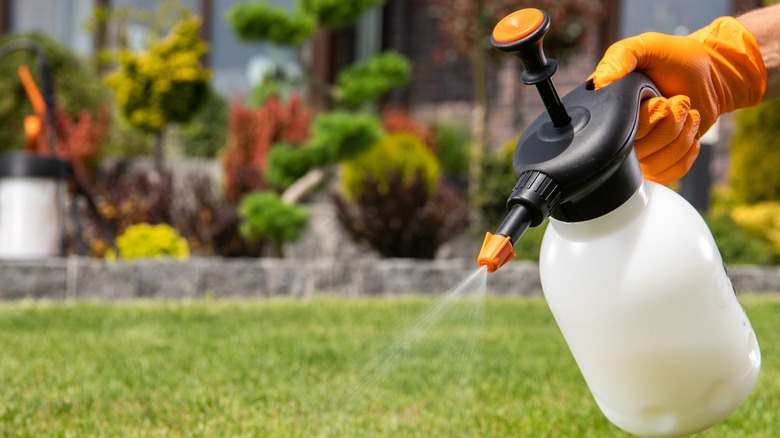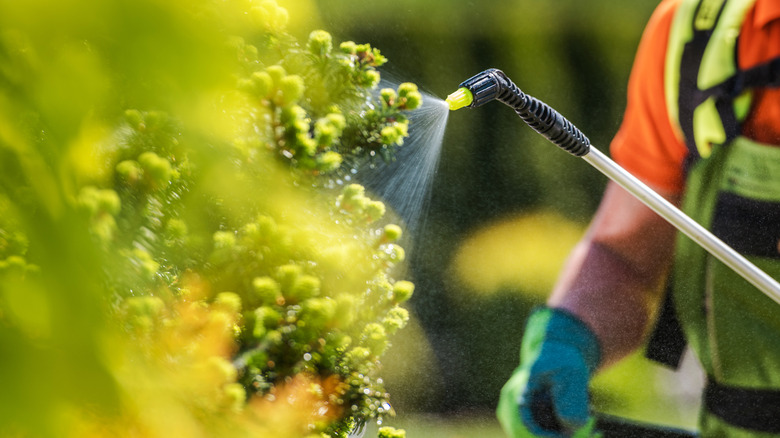Why You Should Think Twice Before Using Granular Weed Killers On Your Lawn
Granular broadleaf killers are small, pellet-like substances that are spread over the lawn, targeting unwanted weeds. Their appeal lies in their ease of application — you can spread them across the lawn using a spreader. However, this convenience comes with drawbacks. The effectiveness of granular weed killers largely depends on their ability to stick to weeds, which is often a challenge. These products are designed to work optimally when the weeds are wet, as moisture helps the granules adhere to the leaves. In dry conditions, the granules tend to fall off the leaf surfaces, reducing the product's efficacy. This results in less-than-optimal weed control and can sometimes require repeated applications to achieve the desired results.
Granular weed killers do have their merits, one of which is their reduced susceptibility to drift compared to liquid formulations, especially in light wind conditions. This makes them a safer choice around sensitive areas where drift might harm desirable plants. Another benefit is their ease of storage and handling, as they are less likely to spill or leak compared to liquids. However, given their limitations, it might help to experiment with concentrated liquid broadleaf killers for a more effective application. When you study how well different weed killers work, liquid broadleaf killers really stand out for their effectiveness and are especially important when dealing with a severe weed infestation. In short, their benefits are much greater than those of granular herbicides.
Benefits of concentrated liquid broadleaf killers
Liquid broadleaf formulations not only stick to weed leaves better and make direct contact with them, but they also allow the herbicide to be absorbed more quickly. This means they can start working almost instantly, leading to their quicker and more thorough elimination. The versatility of liquid broadleaf killers is another significant advantage. These herbicides, available in concentrated forms, allow for easy mixing to various strengths, enabling you to tailor them precisely to your lawn's specific conditions. This flexibility is particularly beneficial when dealing with a wide range of weed types or varying levels of infestation. Whether your lawn is grappling with resilient, mature weeds that require a stronger solution, or you're aiming to prevent the emergence of new weeds with a more diluted mixture, the ability to fine-tune the herbicide strength according to the specific needs of your lawn also means you can achieve optimal results, with minimal waste and environmental impact.
Moreover, the precision in applying liquid herbicides is a notable benefit. Spot treatments, a practical and effective method of applying herbicides, are not very feasible with granular products. Spot treatments allow for targeted application to problem areas, ensuring that only the weeds are dealt with while minimizing the impact on surrounding grass and plants. This treatment method also means you use less herbicide overall, reducing the potential for runoff to lakes and rivers.
Effective application of liquid broadleaf killers using a hose-end sprayer
When applying liquid broadleaf killers to get rid of weeds, the hose-end sprayer stands out as an effective tool — and one that gives yet another advantage over granules. With this device, you can swiftly cover a large area, evenly misting all the weeds, making it possible to treat an average-sized yard in less than 20 minutes. The real charm of a hose-end sprayer lies in its ability to deliver uniform coverage. This means each weed gets just the right amount of herbicide, leaving no weed untreated.
Using a hose-end sprayer also offers better precision. As you start at one end of your lawn, spraying the grass, you'll find that walking backward while fanning the spray from your left to right side is the best approach. This method ensures that every inch of your lawn gets sprayed, preventing uneven application. What's more, it cleverly keeps you from stepping on the herbicide, which may cause unwanted transfers to other areas of your lawn.
The hose-end sprayer isn't just a one-trick pony; some models offer the flexibility to adjust spray patterns and flow rates. This adaptability is key, especially when you're dealing with different weed densities or targeting specific sections of your lawn. However, remember, successful weed control is also about the details. It's important to follow the recommended guidelines for mixing and applying the herbicide. You want to get the concentration right for your lawn's specific needs and choose a time for application when the weather is cooperative—ideally, when there is no rain and the wind is calm.


